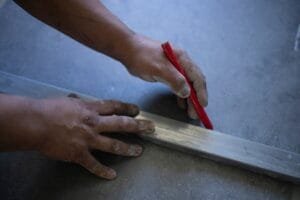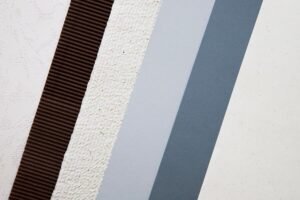Introduction to Metallic Finishes
Metallic finishes are a sophisticated and visually appealing treatment applied to various surfaces to enhance their aesthetic appeal and durability. These finishes involve the application of a thin metallic layer, which can be achieved through different techniques such as electroplating, powder coating, or spray painting. The metallic layer not only adds a lustrous sheen but also provides additional protective qualities, making it a popular choice for both functional and decorative purposes.
Typically, metals like aluminum, copper, gold, silver, zinc, and nickel are used for metallic finishes due to their excellent reflective properties and resistance to corrosion. The selection of metal often depends on the desired visual effect and the specific properties needed for the application. For instance, aluminum is favored for its lightweight and corrosion-resistant characteristics, while gold and silver are often chosen for luxury and ornamental applications.
The desirability of metallic finishes lies in their ability to impart high durability and resistance to wear and weather conditions. This makes them an excellent choice for products exposed to harsh environments, such as automobiles, appliances, and outdoor furniture. Additionally, metallic finishes are highly favored in the interior design and architectural realms for their ability to create striking and elegant visual statements on surfaces like walls, ceilings, furniture, and fixtures.
The process of creating a metallic finish generally involves surface preparation, application of a base layer for adhesion, and the subsequent application of the metallic layer. For achieving different textures and effects, techniques like brushing, polishing, and buffing might be employed. Precision in these steps ensures a smooth, uniform finish that meets both aesthetic and functional requirements.
Understanding the basics of metallic finishes opens up endless possibilities for enhancing the beauty and lifespan of objects in various domains. This intersection of art and science allows for the creation of surfaces that are not only visually captivating but also remarkably enduring. Thus, exploring metallic finishes provides insight into an essential aspect of surface treatment that beautifully balances form and function.

Historical Background of Metallic Finishes in Maharashtra
Metallic finishes have a rich history in Maharashtra, with roots tracing back to ancient times when artisans mastered a range of techniques to embellish their creations. The history of metallic finishes in this region is a testament to the diverse cultural influences and the artistic heritage that continues to thrive today. Originally utilized in the adornment of temples and palaces, these techniques showcased intricate artistry and exceptional craftsmanship.
The traditional methods of creating metallic finishes were largely influenced by the techniques brought in through trade routes and cultural exchanges. Historical records suggest that artisans in Maharashtra used an array of metals including gold, silver, and copper to achieve luminous finishes on objects ranging from religious idols to everyday utensils. Notably, these craftsmen employed methods such as gilding, repoussé work, and inlay techniques to create opulent designs that reflected the grandeur of their times.
One of the earliest and most iconic examples of metallic finishes in Maharashtra can be seen in the Ajanta and Ellora caves. These UNESCO World Heritage sites are adorned with paintings and sculptures showcasing the skillful use of metallic embellishments, which have withstood the test of time. Additionally, the Wada culture prevalent in Maharashtra, characterized by its grandiose mansions, further illustrates the use of metallic finishes in the decor and architecture, serving both aesthetic and functional purposes.
The evolution of metallic finishes in Maharashtra is also attributed to the state’s diverse cultural tapestry, influenced significantly by the Maratha Empire, the Deccan Sultanates, and the British colonial period. Each era brought about new materials, techniques, and styles, enriching the traditional practices. The local artisans ingeniously adapted these influences, blending them with indigenous methods to continue a legacy that is both historic and dynamic.
In modern times, while the techniques have evolved with advancements in technology, the essence of traditional methods remains very much alive. Artisans today continue to draw inspiration from ancient practices, maintaining the unique artistic identity that metallic finishes in Maharashtra are known for. The history of these finishes not only exemplifies the region’s cultural richness but also highlights the enduring legacy of its artisanship.
Types of Metallic Finishes Popular in Maharashtra
Maharashtra, with its rich cultural heritage and vibrant arts scene, has embraced various types of metallic finishes that enhance the beauty and durability of artifacts and architectural elements. Among the most popular choices are brass, copper, bronze, and gold finishes, each of which offers unique properties and aesthetic appeal, making them a staple in many traditional and contemporary designs.
Brass Finishes: Brass finishes, characterized by their warm, yellowish hue, are particularly prized for their historical and regal connotations. The alloy, typically composed of copper and zinc, is widely used in the creation of intricate sculptures, decorative items, and household fixtures. Brass finishes not only provide a timeless elegance but also possess impressive resistance to corrosion, making them ideal for both indoor and outdoor applications.
Copper Finishes: Copper finishes have a distinctive reddish-brown color that can develop a pleasing green patina over time. This natural aging process adds depth and character to the metal, often used in traditional Indian art forms and architectural details. Copper’s excellent thermal and conductive properties also make it a popular choice for cookware and electrical applications. Its versatility and aesthetic appeal make copper finishes a preference for many artisans and homeowners alike.
Bronze Finishes: Bronze, an alloy primarily composed of copper and tin, offers a rich, dark hue that exudes sophistication. Bronze finishes are commonly used for statues, plaques, and other decorative elements, thanks to their durability and ability to capture fine details. The metal’s robustness and dense composition make it suitable for crafting high-quality, long-lasting items.
Gold Finishes: Gold finishes are synonymous with opulence and grandeur. Often used selectively due to its high cost, gold plating or leafing can transform mundane objects into luxurious artifacts. Gold finishes are prevalent in religious icons, jewelry, and high-end decorative pieces. The reflective quality of gold adds a luminous brilliance, making it a coveted choice for elements meant to stand out.
As Maharashtra continues to celebrate its artisanal traditions, the use of these various metallic finishes remains integral to the region’s artistic expression and architectural identity. From ornate jewelry to structural elements, these finishes contribute significantly to the aesthetic landscape of Maharashtra, showcasing a marriage of beauty and functionality.

The Process of Creating a Metallic Finish
The creation of a metallic finish on surfaces, be it on household items, art pieces, or architectural elements, involves a meticulous and multi-step process that is both an art and a science. Understanding the nuances of this process is essential to appreciating the craftsmanship behind the gleaming surfaces that adorn many items in Maharashtra. The procedure can generally be categorized into three phases: preparation, application, and finishing touches.
The preparation phase involves thorough surface treatment to ensure it is smooth and free from impurities. This may include cleaning, sanding, and priming. Different materials require different preparation techniques; for instance, wood might be sanded down, whereas metal surfaces would undergo a degreasing process. Priming is particularly key in providing a stable base for the metallic paints to adhere to, ensuring longevity and maintaining the aesthetic appeal over time.
Next comes the application phase, where traditional methods often intersect with modern techniques. Historically, craftspeople in Maharashtra have used brush application for metallic paints, relying on the steady hand and skill passed down through generations. This method still holds substantial value, particularly in preserving the authentic appearance of heritage pieces. In contrast, modern techniques include the use of spray guns, electrostatic painting, and even automated machines, offering efficiency and uniformity. These contemporary methods are particularly favored in large-scale industrial applications or where high precision is required.
The final stage involves adding the finishing touches. This could include multiple coats of clear varnish or lacquer to seal and protect the metallic finish, enhancing its durability against environmental factors like humidity and oxidation. Polishing may also be part of the process, ensuring a high gloss and a refined, smooth texture. In some instances, additional artistic elements, such as intricate patterns or even the incorporation of mithila paints, known for their vibrant colors and detailed designs, might be applied, adding a unique, local flair to the finished product.
Understanding this detailed process deepens one’s appreciation for the craft, whether one is admiring a piece of traditional artwork, a modern design, or even the stunning facades of buildings that feature a metallic finish. The blend of traditional and modern techniques reflects both the heritage and the innovative spirit of Maharashtra’s artisans.

Notable Artisans and Workshops in Maharashtra
Maharashtra boasts a rich heritage of artisans and workshops that excel in the art of metallic finishes. These individuals and groups not only preserve traditional techniques but also innovate to meet contemporary demands. Among the noteworthy figures is Ramesh Vaidya, whose workshop in Pune has become synonymous with exquisite metallic artworks. Vaidya’s contributions extend beyond mere craftsmanship; he integrates modern tools with age-old methods to produce stunning pieces that appeal to both traditionalists and modern art enthusiasts.
Another significant name in this field is the Palkar family from Nashik. Known for their finely detailed metal sculptures, the Palkars have preserved their craft through several generations. Their workshop stands as a testament to the intricate techniques passed down the lineage. The Palkars have embraced newer technologies such as CAD design to enhance precision without compromising the traditional essence of their work. Their contributions have earned them numerous national awards, reinforcing their status as torchbearers of this heritage art form.
Mumbai’s Kala Nirmiti Collective is another prominent workshop that merges tradition with contemporary needs. This group consists of young, innovative artists who are not afraid to experiment with styles and materials. They often collaborate with designers and architects, creating bespoke metallic finishes for modern spaces. Their work has been featured in various art exhibitions and has garnered praise for its creativity and craftsmanship.
An innovative approach is also evident in Kolhapur’s Rajaram Metal Arts. This workshop specializes in creating Mithila paints with metallic finishes, a unique amalgamation that blends the visual appeal of Mithila art with the rich textures of metal. The artisans here are adept at balancing traditional techniques with modern aesthetics. Their versatility ensures that they cater to a wide range of preferences, from ornamental pieces to functional art.
Collectors and art enthusiasts are often drawn to these artisans and workshops for their ability to combine heritage with innovation. By maintaining a delicate balance between traditional craftsmanship and contemporary demands, these notable artisans and workshops continue to elevate the art of metallic finishes in Maharashtra.
Applications of Metallic Finishes in Architecture and Design
Metallic finishes have garnered widespread acclaim in the realm of architecture and design, particularly in Maharashtra, where they play a pivotal role in enhancing both aesthetic and functional elements across various spaces. From residential to commercial and public settings, the adoption of these finishes has significantly influenced design processes, making them a preferred choice for many architects and interior designers.
In residential architecture, metallic finishes are extensively used to create visually striking and modern interiors. They can be found in elements such as kitchen backsplashes, bathroom fixtures, and living room accent walls. Their reflective properties add depth and light to spaces, creating an illusion of a more expansive environment. Moreover, metallic finishes are durable and resistant to tarnish, making them a practical choice for daily household use.
Commercial spaces in Maharashtra, such as retail stores and corporate offices, leverage metallic finishes to establish a contemporary and professional ambiance. Storefronts often incorporate these finishes to capture the attention of passersby and entice potential customers. Within these spaces, metallic elements are applied to reception desks, display units, and lighting fixtures, offering a sleek and sophisticated appearance that is both inviting and enduring. This choice of material not only elevates the aesthetic appeal but also speaks to the brand’s commitment to quality and innovation.
Public spaces like museums, galleries, and government buildings also benefit from the integration of metallic finishes. These finishes are used to highlight architectural features, create focal points, and enhance the overall grandeur of the establishments. Additionally, metallic elements can be found in structural components and outdoor installations, exemplifying their versatility and resilience in diverse environmental conditions.
The importance of metallic finishes lies not only in their visual appeal but also in their functional attributes. They provide long-lasting durability, ease of maintenance, and the ability to withstand harsh weather conditions, making them an ideal choice for both interior and exterior applications. As a result, the use of metallic finishes continues to grow, contributing to the rich and evolving landscape of architectural and design practices in Maharashtra.

Challenges and Conservation of Metallic Finishes
The preservation and maintenance of metallic finishes in Maharashtra present a series of unique challenges. Environmental factors significantly contribute to the deterioration of these finishes. Humidity and temperature fluctuations can lead to oxidation and corrosion, affecting their sheen and integrity. Moreover, urban pollution, which includes acidic compounds, accelerates the tarnishing process, rendering the finishes less attractive.
Wear and tear is another critical issue. Metallic finishes, particularly in public spaces or on frequently handled objects, are prone to scratches, dents, and abrasions over time. Such physical damage is not just an aesthetic concern but also a gateway for further chemical degradation. The high frequency of use in busy environments makes it almost impossible to completely prevent such wear.
Economic considerations cannot be overlooked when discussing the conservation of metallic finishes. The costs involved in regular maintenance, repair, and restoration are substantial. Many traditional techniques require expensive materials and skilled labor, which adds to the overall expenditure. Even modern conservation methods, while often more effective, come with a significant price tag.
Fortunately, there are advanced techniques and solutions developed specifically for the conservation of metallic finishes. Application of protective coatings is one such modern solution. These coatings can provide a barrier against environmental pollutants and physical damage. Another contemporary approach involves nano-technology, where nanoparticles form a protective layer that shields the metal surface from oxidizing agents without altering its appearance. Preventative conservation is also gaining traction. This proactive strategy includes controlled environments with regulated humidity and temperature levels, which help mitigate the adverse effects of climatic conditions.
Among the modern solutions, regular cleaning using non-abrasive materials and the careful selection of cleaners that do not react chemically with the metals are critical. In some cases, innovative laser cleaning techniques can precisely remove unwanted layers of oxidation without damaging the substrate.
Future Trends and Innovations in Metallic Finishing
As we look ahead, the realm of metallic finishing in Maharashtra is poised for significant transformations driven by technological advancements and inventive materials. These future trends are expected to not only enhance the durability and aesthetics of metallic finishes but also promote sustainability within the industry. A notable emerging trend in this sphere is the use of nanotechnology, which enables the creation of ultra-thin coatings that offer superior protection against corrosion and wear. Such precision in application not only extends the lifespan of metal surfaces but also reduces the need for frequent refurbishments.
Furthermore, advancements in chemical formulations are leading to the development of environment-friendly metallic finishes. The adoption of water-based and low-VOC (volatile organic compounds) coatings is increasingly becoming a norm, addressing the growing environmental concerns associated with traditional solvent-based finishes. This shift towards greener options underscores a commitment to sustainable practices while ensuring that the quality and visual appeal of metallic finishes are not compromised.
In addition to these technological strides, innovative design approaches are shaping the future of metallic finishing. The integration of digital technologies, such as 3D printing and augmented reality, is revolutionizing the way metallic patterns and textures are conceptualized and executed. For instance, intricate designs akin to mithila paints, known for their rich cultural heritage and intricate patterns, can now be seamlessly translated onto metallic surfaces. This fusion of traditional artistry with modern technology presents limitless creative possibilities and offers a fresh perspective on metallic aesthetics in Maharashtra.
Another exciting development is the exploration of hybrid materials that combine the best properties of different substances to create unique metallic finishes. These hybrid materials aim to achieve optimal balance between visual appeal, performance, and environmental impact. As these advancements continue to evolve, it is evident that the future of metallic finishing in Maharashtra will be characterized by a harmonious blend of innovation, sustainability, and artistic expression.

